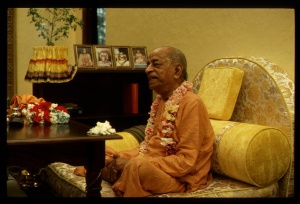SB 4.24.51

A.C. Bhaktivedanta Swami Prabhupada
TEXT 51
- śyāma-śroṇy-adhi-rociṣṇu-
- dukūla-svarṇa-mekhalam
- sama-cārv-aṅghri-jaṅghoru-
- nimna-jānu-sudarśanam
SYNONYMS
śyāma — blackish; śroṇi — lower part of the waist; adhi — extra; rociṣṇu — pleasing; dukūla — garments; svarṇa — golden; mekhalam — belt; sama — symmetrical; cāru — beautiful; aṅghri — lotus feet; jaṅgha — calves; ūru — thighs; nimna — lower; jānu — knees; su-darśanam — very beautiful.
TRANSLATION
The lower part of the Lord's waist is dark and covered with yellow garments and a belt bedecked with golden embroidery work. His symmetrical lotus feet and the calves, thighs and joints of His legs are extraordinarily beautiful. Indeed, the Lord's entire body appears to be well built.
PURPORT
Lord Śiva is one of the twelve great authorities mentioned in Śrīmad-Bhāgavatam (SB 6.3.20). These authorities are Svayambhū, Nārada, Śambhu, Kumāra, Kapila, Manu, Prahlāda, Janaka, Bhīṣma, Bali, Vaiyāsaki, or Śukadeva Gosvāmī, and Yamarāja. The impersonalists, who generally worship Lord Śiva, should learn of the transcendental sac-cid-ānanda-vigraha (BS 5.1) of the Lord. Here Lord Śiva kindly describes the details of the Lord's bodily features. Thus the impersonalists' argument that the Lord has no form cannot be accepted under any circumstance.